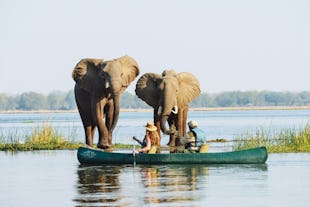
7 active safari ideas
Keep your heart rate high



If you love elephants (and who doesn't?), then the Chobe River should be top of your must-see list. The area hosts one of the largest concentrations of elephants in Africa, and a drive through the Chobe National Park ensures many sightings of these gentle pachyderms. The Chobe River makes up the northern border of Botswana and Namibia and winds through a vast open floodplain that supports incredible concentrations of wildlife such as wildebeest, buffalo, zebra, impala and, of course, the many predators that follow the herds. One of the best ways to experience the river is on a serene Chobe boat safari for an eye-level encounter with the beasts and birds.
Start with a recommended trip or create one from scratch
The Chobe River will become your second home on a trip up here and seeing the famous Chobe elephants and buffalo gather on the banks in their hundreds to splash, play and drink is unforgettable. For maximum exposure and the best view, a boat trip is key and there are different options to suit all styles and requirements. Early-morning trips are longer and often better for birding (Chobe is renowned for its water birds), but sunset cruises have the advantage of spotting nocturnal animals - and a G&T as the sun sets. For photographers, we would recommend choosing a customised, double-decker vessel for spectacular photos. Away from the river, the terrain is a patchwork of mopane woodland and dry, Kalahari soil. The animals are dotted around but quite easy to see, and your sightings list should include cheetah, leopard, lion and spotted hyena. The cats are easier to spot on game drives (usually on offer twice daily, morning and afternoon), but lion are often known to lie in wait for their prey on the riverbank, offering up a good chance of boat-based sightings too.
The Chobe River is one of the only permanent water sources for miles and miles, and that means big game! You’ll spot enormous herds of elephant and buffalo, large lion prides, leopard and wild dog, all against the backdrop of the pretty, riverside setting.
Choose one of the tented camps in Chobe for a more personal and intimate experience. Even if you don’t think "rustic" is quite your cup of tea, these camps are undoubtedly the best way to experience the magic of Chobe.
Its proximity to bucket-list gem Victoria Falls means Chobe does get busy. It’s also a national park (unlike other areas in Bots), so activities are slightly more restricted – no off-roading for example, or night drives, and there are strict rules about timings for entering and exiting the park.
Jan
Feb
Mar
Apr
May
Jun
Jul
Aug
Sep
Oct
Nov
Dec
Wet Season
The weather is characterised by high temperatures, relative humidity and a one in two chance of rain.
The birthing season provides high excitement as predators take advantage of the inexperienced newborns.
A wonderful time for photography, vegetation is lush and in bloom, migratory birds are present and in breeding plumage, the animals are all in prime condition.
Bush walks are a highlight during this period, showcasing the numerous overlooked animals of the ground and in the air.
Make sure the mosquito repellent is packed during this time of year.
Wet Season
In this month temperatures are still high with a drop in humidity and relatively high rainfall.
A month of high excitement, due to the many newborns afoot, predator hunts are a frequent occurrence.
Take advantage spectacular photographic conditions, with vegetation lush and in bloom, migratory birds present and in breeding colours, the animals are healthy and enjoying this time of plenty.
Enjoy exceptional bush walks in February, with smaller game, insects and reptiles particularly active over this period.
At this time of year keep the mosquito repellent handy, especially in the evenings.
Wet Season
Temperatures are still relatively hot, with the number of rainy days decreasing, expect an afternoon shower or two.
Wildlife is a little more spread out than in dryer months, however a good variety of species is still present in the area including numerous predators.
Prime photographic conditions are experienced, vegetation is vibrant and green, migratory birds are strengthening their wings and wildlife is in pristine condition.
Boating provides a different perspective and some cover from the rains should they persist.
Make sure the mosquito repellent is packed during this time of year.
Wet Season
Temperatures begin to fall but are still quite hot, the average daily sunshine hours increases and rainfall is unlikely.
Lion, leopard and wild dog are just a few of the predator's that frequent the region.
Enjoy the last opportunity to view the migratory birds before they head North for the dry winter months.
Bush walks provide an intimate look at the smaller wildlife that make up the unique Chobe ecosystem.
Take advantage of the end of the season, Photographically capturing a lush green wilderness before the dry winter months set in, changing the landscape drastically.
Dry Season
A transition month from wet summer to dry winter, offering moderate temperatures and little to no rainfall.
The end of the "emerald season" is approaching, vegetation will slowly begin to thin and animals will migrate into the area following the year round water sources.
Improved visibility will increase your chances of spotting the rarely seen Sable and Roan antelope.
Explore the smaller lesser showcased species of the Chobe with a bush walk.
A great time of year to star gaze, with relatively few clouds and no ambient light, enjoy a sky twinkling with a blanket of stars.
Dry Season
Temperatures are chilly in the morning and evenings, with the daylight hours being comfortably warm.
Animals begin to migrate back into the Chobe region as water sources dry up elsewhere, leading to increased predator-prey interactions, as they compete for dwindling resources.
Vegetation has started to thin, improving chances of spotting the rare and endangered Sable and Roan antelope.
Walking Safari takes over from bush walks as the on foot activity of choice, showcasing the abundance of big game species.
Boating safaris and sunset cruises are at their best in this month with impressive game viewing and picturesque sunsets.
Remember to pack a winter jacket, as frost can occur on particularly cold June mornings.
Dry Season
The best time to visit, with warm daytime weather, low humidity and not a cloud in the sky.
Vegetation begins to thin due to the lack of rainfall, causing wildlife to converge around permanent water sources and the Chobe River.
July offers quality photographic conditions, long day length, low humidity and sparse vegetation means wonderful image clarity and no shortage picture of perfect moments.
Walking safari in this month provides exceptional encounters and comfortable conditions.
This is the best month to view the African Skimmers, a speciality bird species for the region.
Be sure to pack a warm jacket for the early morning and late evenings, as temperatures become a little chilly.
Dry Season
Enjoy pristine weather, with warm sunny days, low humidity and not a cloud in the sky.
Due to the lack of rainfall vegetation begins to thin increasing the density of wildlife along the remaining water sources and the Chobe River.
A wonderful month for photography, with soft light, low humidity and sparse vegetation offering plenty of opportunity to get the perfect snap.
Head out on foot for an intimate encounter with Africa's wildlife including impressive herds of elephant, buffalo and prides of lion.
Boat cruises provide romantic African sunsets and a unique water based perspective on the wildlife in the vicinity.
Be sure to pack a warm jacket for the early morning and late evenings, as temperatures can get chilly.
Dry Season
The ideal time to visit this region, enjoying sunshine filled days, low humidity and not a cloud in the sky.
This is a great time of year for wildlife viewing, the vegetation has thinned substantially and wildlife is congregating along the remaining water sources.
The greatest density of elephants in Africa can be found around the Chobe River frontage.
September offers ideal photographic conditions, low humidity and sparse vegetation means wonderful image clarity and no shortage of picture perfect moments.
Boating safaris are a welcome change of pace from walking and driven safari, all of which are exceptional in this month.
Be sure to pack a warm jacket for the early morning and late evenings, as temperatures can get chilly.
Dry Season
This is a transitional month with temperatures being very hot and humid preceding the arrival of the wet season.
This is the harshest month of the year, water and food are scarce causing animals to congregate in small areas along the Chobe River.
Game viewing is still very good with vegetation sparse, ensuring quality sightings of a wide variety of wildlife.
Relax with the comfort of a romantic sunset cruise and watch as wildlife come to the river's edge to drink.
Be sure you have a hat and high factor sun block packed.
Wet Season
Temperatures and humidity are still high with the arrival of the summer rains, expect afternoon showers only.
The arrival of the rain replenishes water sources enabling wildlife to spread over a greater area.
Migratory birds begin to return, creating a hive of activity and colour in the tree tops.
Be sure you have a hat and high factor sun block packed.
Wet Season
The temperature is less extreme with lower humidity and afternoon showers providing solace from the heat.
The birthing season kicks off towards the end of the month, causing a buzz of predator excitement.
The "Emerald Season" is the perfect time for photography, plants are green and in bloom, migratory birds are in full breeding plumage and the animals are all in prime condition.
A wonderful time of year to get out on foot, experiencing all the smaller details often missed during game drive.
Make sure the mosquito repellent is packed during this time of year.